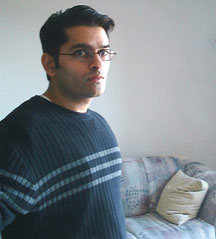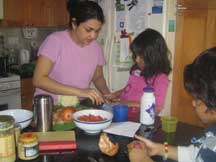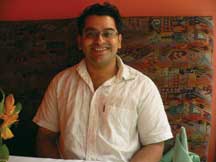Life
Wanna Be A Blogging Star?

Indians carve out a space in the new media frontier.
|
He’s not a rock star or a sports phenomenon, but when he recently suffered a sudden heart attack, the news spread like wildfire through the blogosphere and he received thousands of emails and hundreds of voice messages from fans, friends, techies and bloggers from as far away as Europe and Asia. Meet Om Malik, founder of GigaOm.com, who was named amongst the top 25 Web Celebs worldwide by Forbes magazine. GigaOm.com, the definitive site for all things technical, has been anointed as one of the top 100 blogs by Technorati, PC Magazine and CNET. Business Week named GigaOm.com the “Best of the Web” for tech news. So when his byline went MIA after his heart attack, there was an outpouring from readers. One frantic fan wrote, “Most of us are taught to make ourselves replaceable, but you’ve failed. You aren’t. The blogosphere needs you!” Another wrote: “Man, take it easy. I read your blog every day, and I hope you make a full recovery. You can scale down from GigaOm to MegaOm and still be the best blog out there.”
One of the 1.5 million monthly visitors to his site joked: “Gentlemen, we can rebuild him. We have the technology. We have the capability to build the world’s first bionic blogger. Om Malik will be that man. Better than he was before. Better, will blog more, and attract more readers.” In a world of over 100 million blogs cluttering the blogosphere, Malik’s is a success story that most bloggers can only dream about. How cool is it to be able to sit in your pjs – if you so desire – write whatever you feel like and pull an enviable salary? Starting as a journalist blogging for pleasure, he has emerged as a noted authority on everything hi-tech and his company Giga Omni Media has expanded to a network of sites which are a daily must-read for those following the technology marketplace, offering news, analysis and opinions on everything from broadband to Web 2.0. The company started only in 2006, but it has become the place for trend-spotting and smart analysis of news about Internet telephony, telecom and other new technologies. As the man behind GigaOM.com, Malik has taken the venture from a one man experiment to a world-known media site which raised nearly $1 million in venture financing last year, employs several people and is followed by important players in technology. The story of Rafat Ali of Paidcontent.org is even more dramatic. Only a few years ago he was an out-of-work journalist without a visa. Three times, he remembers, his bank account fell to zero balance and friends had to wire him funds. Today his one-man blog, first eked out from a cramped apartment, has evolved into ContentNext Media network, a powerful media company, encompassing four blog sites and has offices in California, New York, London and India. The blogs include paidContent.org, mocoNews.net, a news site covering the business of mobile content, and Content Sutra.com, covering the Indian digital content market. PaidContent secured venture capital funding in 2006 and is reportedly shopping for $3 to $5 million in additional funding, according to the technology blog TechCrunch.com. Ali has repudiated that report as well as suggestions that the site is seeking to sell for $15 million, saying “We’re not yet ready.” Ali would not discuss the company’s finances in any detail, saying only: “We crossed seven figures two years ago. It’s a fast growing company and it’s grown quite a bit since then.” The blog has an influential niche readership, claiming three million page views every month and its RSS feed has 50,000 readers. Indian Americans are already prominent in the hospitality industry, academe, medicine, engineering and information technology. Is blogging the next frontier? Indians are tech-savvy, love to argue and talk and opinionate, so blogging and desis seem a match made in cyber heaven. There are literally thousands and thousands of desi-run blogs in India and the Diaspora, but as blogging is a relatively new phenomenon, which is slowly metamorphing from a hobby to a profession for many, statistics are hard to come by.
Sreenath Sreenivasan, who teaches new media at Columbia University and is also a technology reporter for WNBC-TV, says: “It’s hard to quantify, because there are just so many and they are not tracked very well. The answer is there are many and some of the big players are Indians.” Anil Dash, one of the earliest bloggers, has turned his passion into a full time profession. He maintains several blogs, including one named after himself. He is “chief evangelist” at Six Apart, a noted blogging company, which created Typepad, a blogging service used by thousands of bloggers. An expert on blogs and web culture, he founded one of the earliest weblogs on the Internet. In India, Amit Agarwal runs the highly influential Digital Inspiration blog (labnol.org) on computers, software and the Internet, and also writes technology columns for several newspapers. Digital Inspiration, which started in 2004, is rated the 40th most-favorite blog by Technorati. Digital Inspiration won the Best Technology Blog award at Indibloggies 2006, and is also included in the prestigious “Blogs of Note” list compiled by the Blogger team at Google. The site claims to average 2 million page views every month. The blogs run by Indians that have succeeded financially all seem to be technology-focused. Says Rafat Ali, “I would say it’s kind of natural, because the technology people are usually the early adaptors in this, so that was the low hanging fruit, so as to speak. Now it’s moving into other fields. Huffington Post, for example, is also a blog media company but it’s not about technology, but politics. After technology, politics is the second one that took to blogging in a big way.” As blogs proliferate, one is hard pressed for the precise definition of a blog. At its core, a blog displays entries in reverse chronological order. Some blogs are simply online personal diaries; others are comprehensive websites for news and commentary on particular subjects, akin to many websites, but with distinctive points of view. However, says Malik: “Blog means many different things to many different people. It’s not a one size fits all, and what a lot of people don’t seem to realize is that it’s more about how you perceive the blogs to be. It has to have original content and an opinion or a voice. It could be a diary or basically about your life. You have to say something to connect with people and if you don’t, then it’s kind of pointless.” Blogs continue to evolve and may not even be called blogs in the future. Says Sreenivasan, “I tell people don’t get hung up on the word blog, it doesn’t matter. It’s a tool and it might change in a few years, something new may come along.”
He points out that Facebook, deli.cio.us, Twitter are all different technologies which all have a place along with blogging: “It’s like saying only newspapers count, magazines count, dailies count, weeklies count. They are different ways for people to connect with the world. What is fascinating is that every minute someone spends on Facebook, on Scrabulous, on Twitter, on Om’s blog, is time that is not being spent on traditional TV or reading traditional newspapers.” He adds: “Keep in mind so many new technologies are coming out all the time. I don’t tell my students they must all start blogging, because it’s a very hard business. But at the same time I see people like Rafat or Om who have succeeded at it. If you have a commitment and a passion about something and you pursue it in a smart way, it is possible to really raise your profile and have a big success.” Scores of India-related commercial blogs and websites have been monetized, covering everything from Bollywood and cricket to personals and matrimonial sites, but then there are many more others that do not make money, but are very individualistic and influential, such as Amit Varma’s blog Indiauncut.com, which won the prestigious Bastiat Prize for Journalism in 2007, with a prize of $10,000 and an engraved crystal candlestick, evoking Frédéric Bastiat’s satirical essay in which the candle makers of France petition the government to block out their competition – the sun. Varma, who is editorial columnist for Mint (a joint venture between the Wall Street Journal and The Hindustan Times) beat out a senior editor of the Atlantic Monthly and a contributing editor to National Review, who won second and third places. Varma also runs Indianeconomy.org, which gives a comprehensive picture of the Indian economy. Says Sreenivisan about the connection between writers and blogging: “The reason why they’re so successful is that there are so many desi writers and they’ve realized that blogging is a great way to get the word out on whatever they are interested in. It really works well for niche topics.” Sreenivasan also believes blogging can be an important form of communications for nonprofit organizations, such as the South Asian Journalists Association (SAJA) of which he is a co-founder: “What’s interesting about blogging is that people are able to post quickly and post things they are interested in and have an audience and have a conversation with their audience, which is much harder to do.” Saja.org was one of the early South Asian websites, but the exposure grew substantially once the organization started Sajaforum.org, a blog about South Asia with contributions from journalists. He says: “The blog has allowed us to make connections around the world in a way that our website or our email list did not. I was skeptical in the beginning, but you can see the power of it for any nonprofit temple or mosque and the SAJA experience is exactly that.”
He says that the impact is far beyond dollars and through the blog the organization has connected with readers around the world, and often stories have been published in the mainstream media based on blog posts. SAJA has benefited from pledge drives on the blog and also created a community of those interested in all things South Asian. Blogging, once regarded as the occupation of geeks, has now found favor with just about everyone – the elite, the disenchanted, the power CEOs. Even Donald Trump has a blog! Perhaps the most wonderful part of blogging is the sheer democracy of it. Anyone with something to say can set up shop; all that is needed is a domain name and some real estate in the blogosphere, which costs pennies compared to space in the real world. Anyone can become the master of his own kingdom. Indians, both at home and in the Diaspora, have established tens of thousands of blogs on every conceivable subject. Little India asked the two most influential desi bloggers Om Malik and Rafat Ali to help map out a route to big bucks in the blogosphere and share their stories of struggle and success. Both started their journalism careers in India and each took a different route. Recalls Malik, “Rafat and I were the early guys, so we were amongst the pioneers of this whole space and both of us just happened to be of Indian origin.” Rafat Ali, who was born in the UK, lived in the United States until he was five years old before his family moved to Aligarh in India. He completed his education in India and he recalls covering the first Internet conference in 1997 for a magazine he was then working for, which got him started on writing about new and digital media. He came to the U.S. to pursue his masters in journalism in 1999. Homesick in Indiana, he started writing a personal blog to overcome a difficult transition. He says, “At that time there were very few bloggers. You could count them in double digits, if not triple digits. There were probably only a 100 or 200 bloggers in the world at that time. The Internet was so new that bloggers knew who the other bloggers were and it was such a small community.” Fresh out of school in 2000, Ali found the dotcom bubble had already burst and there were few job opportunities. He got a job with inside.com, but it lasted only 18 months. He worked for Silicon Alley Reporter in New York before it too shut down. He recalls, “Not being a US citizen, I needed a visa to get work and I got sick of trying to hunt for jobs in the recession.”
As part of his continuing job search he started a blog as a sort of interactive resume. He called it paidcontent.org and recalls that it started not as a personal opinion blog, but as a news site to show prospective employers what he could do. As a journalist he had been tracking the trend of monetizing sites, with major sites like The New York Times and Wall Street Journal experimenting with paid content on their sites. He called the site PaidContent, although the trend has now passed. The blog of reporting on this trend started as a hobby, but took on a life of its own, with journalist friends and others in the industry linking to it. Meanwhile still jobless, Ali went to London where he at least had citizenship. He recalls the hard days in a place that was home and not quite home. “I rented a dingy little room above an internet café. The same people owned both so they allowed me to take a line up to my room and also a phone line. So this was much cheaper than I officially trying to get it from the phone company or the internet company,” he recalls. “And I had a laptop. That’s how I started my company and at least three times my friends had to send me some money to get me out of a zero bank balance.” His job search led nowhere, but amazingly word of mouth had spread about the blog and he started getting inquiries from prospective advertisers. “I didn’t know anything about advertising or sales or anything like that,” he says. “I didn’t even know how much to charge, so I made up a figure of $400 per month for a banner ad.” Before he knew it, he was being invited to conferences in the U.S., the ads started growing as did the readership and the whole thing took off. He moved back to the U.S., this time to California, and the blog turned into a full time business, growing to two, then three, and now four blogs. The latest site is paidContent UK which covers the UK digital market. When it comes to monetizing the site, advertising is just part of the mix, since the company now also hosts events and networking mixers, seminars, webinars and conferences. The real and virtual worlds have blended together. PaidContent is now a full-fledged media company with a staff of journalists and business people, but it remains a blog at its core. All four sites are essentially in blog format, and as Ali points out, the posts also run on the blog philosophy: “They are short, updated constantly and are in reverse chronological order – fresh any time you come to the site.” The company employs 22 people based in Santa Monica, Calif., besides journalists in London, Seattle, New York and India and has received its first round of venture capital. Paidcontent secured funding from Alan Patricof, founder and managing director of Greycroft LLC, who also founded New York magazine in 1967. Ali says, “He invested in us and he understood the journalism part very well, unlike others who are more into consumer internet companies.” The amount was “considerably under $1 million,” but, says Ali, it gave the small company legitimacy and opened many doors on the business side. Om Malik followed a similar trajectory from journalist to blogger. A noted business writer, he had worked with Forbes.com and Red Herring, and was also author of Broadbandits: Inside the $750 billion Telecom Heist. He started the blog in 2001, at a time when the Red Herring was undergoing tough times and he wanted a home for all the pieces which never made it into publication. He began emailing his contacts and gradually people started gravitating toward it. He also put the blog address below his signature and the clicks started. Most emails were to sources and people in the telecom and technology industry and it just grew from there. The main thing in blogging, he says, is to write everyday for that is the key to people coming back more often. It took a couple of years and the audience kept growing. Says Malik, “I didn’t do anything magical. I just do what I do and that was it. The greatest thing about blogging is the freedom to write about anything. It’s also being very judicious about picking what you want to write about. There are a lot of people who write about anything and everything. I can’t do that. I have to be very selective and give as much value to my readers as I can.”
Malik raised some venture capital in 2006 (he is coy about the finances) and basically tried to mould the blog into a publishing business: “We now publish six blogs and we continue to add more and more properties to this. I think this is a new kind of publishing medium and I’m trying to make a business of it for now.” While the company is profitable, it’s breaking even because it continues to expand and invest in the business. Malik says that his company is like any other Silicon Valley startup with employees who have an ownership stake in the company. For writers who’ve worked in traditional print media, this is a welcome benefit. “My thing is if my writers are going to make me successful I want my writers to have a piece of that success,” he says. “It’s not that things happen in isolation. I love working with the people I work with, but I also want them to get rich.” His typical day starts and ends with the computer, with a lot of multitasking, often with several screens open. So it’s really a passion, something he can’t turn off in a way? “Yeah, there were nights when I would go to sleep thinking about this whole blogging thing and if there was some blogging idea in my head I would get up at 3 a.m. and just write it – because I couldn’t sleep because of that. “Yes, it’s obsessive. It’s a big obsession otherwise you can never do this. It’s a very competitive business. You’re competing with everyone from large media companies to other bloggers. You have to not only be fast, you also have to be smart – very, very smart. If you’re not smart, people are going to stop reading you. It’s almost like American Idol, you know – you’re off your game and you’re out. It’s as simple as that. And it’s like American Idol 24/7.” So is there a future in blogging for those who want to make a living of it? “Well it depends. You have to be realistic and also smart about it,” says Ali. “You have to have the knowledge or experience about your topic or be an expert in the field. Then you have to figure out if there are a lot of competing websites in this field and even traditional media companies who have websites and are going to be competing against you, and how much advertising potential something like this has. It has to be a rational decision based on your journalistic and business environment.” He is almost an evangelist for journalists as entrepreneurs and believes established journalists who have been working in media companies can break away and start their own thing. His advice is never to skimp on good financial help, because the business side of the blog is equally important. “You don’t know how the publishing industry is going to shake out,” says Malik. “At least you have to try and build something. We have ways to go, you have to grow in size, and you have to weather the recession and advertising downturn and all those kinds of things.” He adds: “It’s your own baby, you tend to do more when it’s your own thing. It’s like you keep writing about baseball and one day you get to play it; it’s pretty much the same thing for me also. I’ve been writing about startups and technology for so long and now I get to do it. It’s a challenge and its fun and I wouldn’t do anything else. This is it for me. This is my life and I’m pretty happy about it.” Every successful blog evolves from a passion. For desis, what can be a bigger passion than Bollywood and cricket? A blog by that name by Laksh Khamesra (the 2006 Best Blogger of India) is on the Technorati top 100 blogs as is Pronet Advertising, a weblog about Neil Patel’s personal experiences in online marketing.
Which brings us to the scores of people who blog just for the pleasure, and prominent amongst these sites are Sepiamutiny.com, Ultrabrown.com, UberDesi.com, Pickledpolitics.com, All Things Pakistan (www.pakistaniat.com), DesiPundit.com, Jabberwock (jaiarjun.blogspot.com) and The Middle Stage (middlestage.blogspot.com). Fun blogs include www.filmiholic.com and www.passtheroti.com . Movie based blogs www.businessofcinema.com, and www.passionforcinema.com are for the cinema buffs. An important voice in blogosphere is that of author and journalist Sonia Faleiro (Svaradarajan.blogspot.com) “Reality, One Bite at a Time” is the blog of Indian journalist Siddharth Varadarajan. “Arbitrary Obsessions. Cities. History. Music. Feminism. Maami-isms. Patterns. Halwa. Identities. Free Verse” are the passions for London based Neha Viswanathan on her popular blog www.withinandwithout. These are just a sampling of the thousands of blogs powered by South Asians. The blogs have created communities around issues that move them. Manish Vij was one of the founders of Sepia Mutiny and now runs Ultrabrown, a South Asian art blog. Vij runs a software company in Boston and started Sepia Mutiny in 2004 for desi bloggers to cover the Democratic National Convention. He recalls, “Abhi Tripathi had the vision, I coded and designed the site, and six of us wrote the posts. Sepia Mutiny’s strength is its coverage of desi U.S. politics.” Vij started Ultrabrown in 2006 as an arts blog on desi literature, movies and music, and publishes high-quality writing and covers the Diaspora, with the input from five regular writers. Both sites have a distinct readership, he says. “Ultrabrown gets a high-end, tech-savvy audience with deep interest in the arts. We’re like the arts section in the paper with a news sidebar. Sepia is more mass-market with 10-15,000 visits a day. They’re like the front page with an arts sidebar.” He says that while Ultrabrown readers come for well-written arts and literature posts and a deep list of desi book readings, movie releases and album launches, Sepia readers come largely for the active comments section, with upward of 100 comments on many new posts. Ask him about the impact of desi bloggers on the blogosphere and he says: “The diasporic blogs flex the most muscle around incidents of blatant racism, such as calls for boycotting racist radio DJs and such. They’re best at broadcasting and coordinating information. Coordinated boycott calls have been effective, but the traditional political organizations probably still have more effect on the ground.” Sepia Mutiny is smart, witty and very much the domain of second generationers. You can expect original and often acerbic responses to news from the resident bloggers, each of whom has very different sensibilities and points of view. This causes animated dialogues on everything from politics to race to pop culture and the comments come thick and fast. Anna John is one of the unique voices on Sepia Mutiny. A consultant in Washington D.C., she has a crazy schedule at work and yet devotes enormous amounts of time to the blog. Her interest is driven by pure passion without any monetary remuneration, done at the expense of one’s own quality of life: the laundry languishes in a basket, dinner doesn’t get cooked and often relationships suffer. She is one blogger who has opened up her own life on the blog, and that honesty and courage has helped her create strong connections with her readers. Her post about being date raped while in college got thousands of responses and started a dialogue about something that happens much more frequently than one cares to admit. Over the years, she has forged countless connections and she gets emails asking her about every problem under the sun and she’s often hard-pressed to explain that she’s not qualified to answer. It’s not always smooth sailing though and sometimes her posts evoke very vicious responses. She says, “Those are the moments when I wonder, What on earth was I thinking?’ At other times, people find it accessible and decide to participate and it’s a beautiful sort of snowball effect.” She says about Sepia Mutiny and its readership, “I’m so proud of the fact that we’ve managed to live together in a community. It really is a community. People have met in real life. It’s mind-blowing to me, some of the connections that have been made.” Some blogs based are written by professional journalists and an extension of their media brand. But in the truly democratic surroundings of the blogosphere, anyone can blog and hold court on what they love. National boundaries fall away in the blogspara and Indians in the homeland and faraway shores can connect and draw just about everyone in to chat about everything from the nuclear deal to amma’s sambar. Roopa Unnikrishnan, a high powered business consultant, loves cooking with her four year old twins and was surprised to find there were desi mom bloggers (desimomszclub.blogspot.com). She says, “It’s a lovely forum where mothers get to share, empathize and discuss current affairs. My posts there have varied from sharing articles on teaching kids about money to ruminating on discussing the Spitzer affair with kids. It’s a really warm environment, where multiple lines of chat co-exist.” On her own blog, rooparecipes.blogspot.com, Unnikrishnan writes about food and cooking with her kids, imbuing it with the values and warmth that surrounds these activities. What motivates her to blog day after day? “It’s just a question of sharing,” she says. “Funnily, the single entry that got the most visits was one in which I talked about the Indian tradition of flavoring water with herbs. It seemed to have hit quite a chord, with people writing to me about herbs their moms used and getting quite nostalgic about a simple thing like water!” She says a big motivator for her is the hope that her kids will click through to the blog when they are older, and enjoy the discussions they had via the blog. Like lush foliage in the monsoons, the blogs continue to proliferate. It may be morning in Mumbai and night in New York, but in the principalities of the blogosphere, someone is always awake, zapping words, thoughts and ideas through cyberspace, creating a silent cacophony. Every day somewhere around the globe, countless new blogs are being created. Blogs on music, food, personal quirks, new worlds and old remembered ones, blogs on ethnicity, politics, economy and the arts, each with a personal perspective, each a total sharing of one’s self. Who knows which one may become the next GigaOm?
|










You must be logged in to post a comment Login